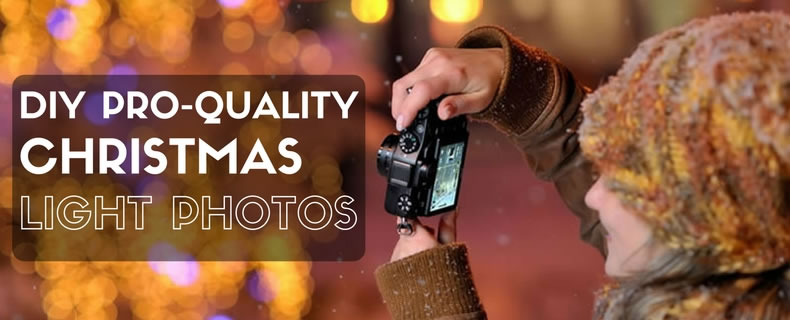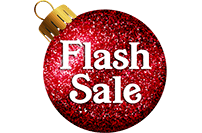DIY Professional-Quality Christmas Light Photos
How to Take Pictures with Christmas Lights in the Foreground or Background
Christmas comes but only once each year. And each passing holiday season offers you the opportunity to add to your stash of precious Christmas memories. But there's no better way to supplement those memories than through the magic of photography. The Christmas season provides many photographic opportunities. But perhaps no other offers quite the combo of allure, brilliance, and breathtaking beauty as Christmas light displays. Untold amounts of labor and money are poured into creating spectacular Christmas light displays each year. And their viewing - as well as the opportunity to create stunning, memorable photos - is free for the taking. This blog discusses how to take pictures with Christmas lights in the background. Capturing the brilliance and magic of Christmas lights through photography can be difficult. How to take a photo of Christmas lights that brings joy to the holiday season is different than simply using Christmas lights in photography. It requires patience and skill. Luckily, we're here to offer a few tips on your Christmas lights photoshoot opportunities. Continue reading to learn more about how to photograph Christmas lights.
Challenges with Bright Backgrounds Indoors
Indoor pictures of holiday lights need to account for dim lighting. You can either address the challenges of dim indoor lighting by using your flash or increasing your camera’s sensitivity (ISO). Using ISO for your indoor pictures can be challenging and you run the risk of too much noise in your images. Using your flash correctly is the best way to address the problem of dimly lit indoor lighting. However, before using flash, you should move the object away from the Christmas lights. You need to give the object space from the Christmas trees because the flash can spill, “flattening” the object. The next thing you need to do is decide whether you want the Christmas tree to blur in the background or be in focus. If you want to blur the Christmas tree in the background, you'll need to use a wide aperture on your lens. If you want to include the Christmas tree in your frame, distance yourself from the subject and use a smaller aperture.Using the Flash
The quality of your Christmas photos depends on what flash you have on your camera. If you have a pop-up flash on your camera and don’t have an external flash or Speedlight, you’ll have to be careful with creating shadows in the background. The pop-up flash is a direct light that can alter the picture. If you have a Speedlight you can either use it on or off-camera. Avoid angling your flash at the Christmas tree because it will emit too much light into the camera and distract from the subject. A workaround for this is to shoot through an umbrella, which will soften the direct light. Shutter Speed
Shutter Speed
You will also need to adjust the shutter speed for indoor photos. The shutter speed adjusts the amount of light the camera lets in. A slow shutter speed means your camera captures longer increments of time. With a longer shutter speed, moving objects become blurrier. So when you’re photographing Christmas lights, you should keep a slow shutter speed and a still camera so your lights will come through clearly. Then you can adjust the aperture (f-stop setting) to allow a deeper or more shallow depth of field, adding the right artistic balance to your photograph.
Equipment You Need for Shooting Christmas Lights
A Camera and Lens
For the best results, you’ll need a DSLR or mirrorless camera. However, newer phones can do the trick just fine. Smartphones won’t give you the detail and performance of more advanced cameras, but there are also apps that offer more control over camera settings.Tripod
Stabilization is one of the most critical components of taking high-quality photos of Christmas lights. Without a stabilization system such as a gimbal, a tripod is your best bet. With a tripod, you can get sharper photos, less grain, and you’ll have more creative options when you can easily steady your camera.Cold-Weather Gear
Since Christmas occurs in winter, you’ll need cold-weather gear to protect your equipment. If you’re shooting in snow, you should consider working with a weather-sealed camera or a rain cover. Fingerless or touchscreen gloves also aid in your ability to shoot. Tip #1: Christmas Lights Photography Requires Careful Time Management
Tip #1: Christmas Lights Photography Requires Careful Time Management
Though it may seem counterintuitive, full-on nighttime is not the best time for Christmas light photography. If you’re looking for a Christmas light photoshoot at night, you can expect the Christmas lights to look like they’re floating in a black blob. Shooting Christmas lights requires enough ambient light to reveal some of the surrounding details accompanying the lights.
Taking pictures of lights is best done in the early evening and early morning when you can catch the light at optimum levels. The best approach is to arrive at the scene of the Christmas light photoshoot a bit before you expect the light to be at its best. Then, wait for the light to become picture-perfect as the sun rises or sets. What are the best camera settings for dusky light levels? Select a high ISO (light sensitivity) on your camera setting in the range of 400 to 800. Be sure to disable the automatic flash. And you'll want to set your camera's white balance to one of two options:- Tungsten: This setting will cause clear bulbs to appear white. And the dusky sky will be captured with a royal blue hue.
- Daylight or Cloud Cover: These settings will cause clear bulbs to appear as more of a warm white, and colors will be more saturated (richer, but possibly trending toward overly bright). Sky colors will tend to be more natural in hue.
Tip #2: Feature the Lights, But Don't Ignore the Surroundings
 When discussing how to take a photo of Christmas lights, it goes without saying that Christmas lights should always be the primary subject of your photo. But your picture will be much more interesting and appealing if it shows more than just the lights. Look for photo decorations you can include in the shot that will add depth and drama to the photo, such as:
When discussing how to take a photo of Christmas lights, it goes without saying that Christmas lights should always be the primary subject of your photo. But your picture will be much more interesting and appealing if it shows more than just the lights. Look for photo decorations you can include in the shot that will add depth and drama to the photo, such as:
- The Sky: Angling your shot upwards so that it includes a significant portion of the sky can add depth to your photo. And under certain conditions, the sky can also add great drama to your photo, showing perhaps the remains of a brilliant sunset, or the moody effect of clouds, or the moon and a few bright stars.
- Trees, Foliage, Lampposts, etc.: A massive oak; a snow-covered pine; a lamppost that casts an enchanting, accompanying glow. Survey the scene with a critical eye to see what you can include in the shot that will enhance the scene without upstaging the star of the show: the Christmas lights.
- A Reflective Foreground: If you're fortunate enough to be able to include a reflective surface in the foreground of your picture, the result can be startlingly dramatic and beautiful. A surface of water or ice in the foreground can offer a mirror-like reflection. And in the right circumstances, an unbroken plane of snow can also offer a surface that will reflect the glow of the Christmas lights.
Tip #3: Keep it Steady, Freddy
Few things can ruin your Christmas light photos quicker than a camera shake. Keeping your camera rock-solid still when you're taking photos of Christmas lights is absolutely critical. That's because even the slightest movement as the photo is snapped will cause deterioration in the clarity of the image - particularly in the low-light conditions you'll be facing. And even the steadiest of hands can impart enough movement to the camera to impact photo quality. The best way to keep the camera steady is to keep it out of your hands by using a tripod. If a tripod isn't available, try leaning against something solid like a fence or a wall as you shoot the photo.
And whether the camera is tripod-mounted or handheld, try using either a timer or shutter release cables instead of your finger to trigger the shutter. That will help to reduce the movement of the camera and will minimize blurring.
The best way to keep the camera steady is to keep it out of your hands by using a tripod. If a tripod isn't available, try leaning against something solid like a fence or a wall as you shoot the photo.
And whether the camera is tripod-mounted or handheld, try using either a timer or shutter release cables instead of your finger to trigger the shutter. That will help to reduce the movement of the camera and will minimize blurring.







